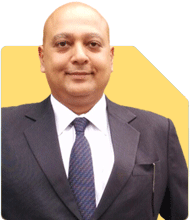Ramalingam Kalirajan |6143 Answers |Ask -Follow
Mutual Funds, Financial Planning Expert - Answered on Jul 18, 2024
He has an MBA in finance from the University of Madras and is a certified financial planner.
He is the director and chief financial planner at Holistic Investment, a Chennai-based firm that offers financial planning and wealth management advice.... more

Hi Sir, I'm Bala, 32/yo aggressive investor with a homemaker wife &a 6-month-old daughter, relying on a single income 1.2L/pm Take home. Rental house. I've been investing for nearly 10 years. Current Portfolio: - Equity: Rs 23 lac (MF: Rs 13 lac, Stocks: Rs 11 lac) with SIP of Rs 42,000 (Nippon Large: Rs 5,000, Quant Small: Rs 5,000, Parag Parikh Flexi: Rs 10,000, ICICI Prudential: Rs 10,000, Motilal Midcap: Rs 8,000, Nippon multicap: Rs 4,000) - Debt: Rs 21 lac (PPF: Rs 9.5 lac, Bonds: Rs 2 lac) - Gold: Rs 6 lac Retirement: Rs 13 lac(EPF: Rs 8.5 lac, NPS: Rs 4.5 lac) Goals: - Child's education - Building a house in Chennai - Rs 3 crores for retirement by age 60 - Trying to Financial independence by age 50. Should I continue with this portfolio for the long term (15-20 years)? Pls advise.. Thank you.
It's impressive to see your well-structured portfolio and dedication to investing over the past decade. Let's dive into your financial situation and provide some comprehensive advice.
Current Financial Snapshot
Income: Rs. 1.2 lakh per month.
Dependents: Homemaker wife and 6-month-old daughter.
Living Situation: Renting a house.
Investment Experience: 10 years.
Investment Portfolio:
Equity: Rs. 23 lakh (MF: Rs. 13 lakh, Stocks: Rs. 11 lakh).
SIP: Rs. 42,000 per month across various funds.
Debt: Rs. 21 lakh (PPF: Rs. 9.5 lakh, Bonds: Rs. 2 lakh).
Gold: Rs. 6 lakh.
Retirement: Rs. 13 lakh (EPF: Rs. 8.5 lakh, NPS: Rs. 4.5 lakh).
Financial Goals
Child's Education: Major future expense.
Building a House: Desire to own a house in Chennai.
Retirement Fund: Aim for Rs. 3 crores by age 60.
Financial Independence: Target by age 50.
Appreciations
Investment Discipline: Consistent investments over 10 years is commendable.
Balanced Portfolio: Good mix of equity, debt, and gold.
SIP Commitment: Significant monthly SIP contribution.
Portfolio Assessment
Equity Investments
Diversification: Ensure a balanced exposure across sectors and market caps.
Active Management: Actively managed funds offer professional expertise and can outperform index funds.
Debt Investments
PPF: Safe and tax-efficient. Continue contributions for long-term stability.
Bonds: Low-risk component adds balance to your portfolio.
Gold
Hedge Against Inflation: Gold provides a safety net during economic uncertainties.
Proportion: Maintain gold at a smaller percentage of your overall portfolio.
Investment Strategy
Mutual Funds
Active vs. Passive Funds: Actively managed funds can yield better returns with professional oversight.
Regular Funds: Investing through a Mutual Fund Distributor (MFD) with a CFP credential offers guidance and performance monitoring.
Direct Stocks
Risks: Direct stocks carry higher risks. Ensure thorough research and periodic review.
Balanced Approach: Keep a balanced approach between direct stocks and mutual funds.
Financial Planning for Goals
Child's Education
Education Fund: Start a dedicated fund. Consider child-specific mutual funds.
Time Horizon: Plan for the long-term to ensure sufficient corpus by the time your child needs it.
Building a House
Non-Investment Advice: Avoid real estate as an investment option. Save and invest in other instruments for down payment.
Planning: Set aside a specific amount each month towards the house fund.
Retirement Planning
EPF and NPS: Continue contributions for a secure retirement.
Target Corpus: Aim for Rs. 3 crores by 60, considering inflation and future expenses.
Financial Independence
Early Retirement: Focus on building a diverse portfolio. Increase SIP amounts if possible.
Passive Income: Explore low-risk, stable investment options for generating passive income.
Risk Management
Insurance: Ensure adequate health and life insurance. It protects your family's financial security.
Emergency Fund: Maintain a separate emergency fund covering 6-12 months of expenses.
Tax Planning
Tax-saving Instruments: Utilize options like ELSS, PPF, and NPS to reduce taxable income.
Efficient Filing: File your taxes accurately and seek professional help if needed.
Final Insights
Continuous Review: Regularly review and rebalance your portfolio to align with your goals.
Professional Guidance: Consult a Certified Financial Planner for tailored advice and strategies.
Stay Informed: Keep learning about personal finance and stay updated on market trends.
Best Regards,
K. Ramalingam, MBA, CFP,
Chief Financial Planner,
www.holisticinvestment.in
Best Regards,
K. Ramalingam, MBA, CFP,
Chief Financial Planner,
www.holisticinvestment.in
You may like to see similar questions and answers below
Omkeshwar Singh | Answer |Ask -Follow
Head, Rank MF - Answered on May 30, 2022
Nikunj Saraf |308 Answers |Ask -Follow
Mutual Funds Expert - Answered on May 24, 2023
Ramalingam Kalirajan |6143 Answers |Ask -Follow
Mutual Funds, Financial Planning Expert - Answered on Jul 24, 2024
Ramalingam Kalirajan |6143 Answers |Ask -Follow
Mutual Funds, Financial Planning Expert - Answered on Aug 16, 2024
Dr Dipankar Dutta |503 Answers |Ask -Follow
Tech Careers and Skill Development Expert - Answered on Aug 29, 2024
Dr Dipankar Dutta |503 Answers |Ask -Follow
Tech Careers and Skill Development Expert - Answered on Aug 29, 2024
Dr Dipankar Dutta |503 Answers |Ask -Follow
Tech Careers and Skill Development Expert - Answered on Aug 29, 2024
Radheshyam Zanwar |685 Answers |Ask -Follow
MHT-CET, IIT-JEE, NEET-UG Expert - Answered on Aug 29, 2024
Sushil Sukhwani |519 Answers |Ask -Follow
Study Abroad Expert - Answered on Aug 29, 2024
Sushil Sukhwani |519 Answers |Ask -Follow
Study Abroad Expert - Answered on Aug 29, 2024
Sushil Sukhwani |519 Answers |Ask -Follow
Study Abroad Expert - Answered on Aug 29, 2024
Sushil Sukhwani |519 Answers |Ask -Follow
Study Abroad Expert - Answered on Aug 29, 2024
Sushil Sukhwani |519 Answers |Ask -Follow
Study Abroad Expert - Answered on Aug 29, 2024
Ramalingam Kalirajan |6143 Answers |Ask -Follow
Mutual Funds, Financial Planning Expert - Answered on Aug 29, 2024














.jpg)










